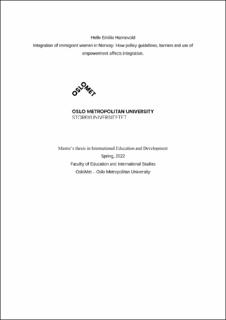| dc.description.abstract | This thesis has examined one aspect of integration in Norway, namely integration of female immigrants through employment or education. The focus of the thesis, however, has been on the service providers’, or street-level bureaucrats’, point of view. Through a case study of one Jobbsjansen project, the thesis aims to answer three research questions. Immigrants are more often outside the work-life than the rest of the population. In addition, immigrant women often experience more obstacles than immigrant men. Immigrant women, therefore, have a larger need for customized programs and aid than immigrant men. It is therefore valuable to document experiences with what works in targeted programs such as Jobbsjansen who have a high goal attainment of helping women into work or education. High employment rates benefit both society as a whole and the individual. Being unemployed can lead to outsidership, social differences, and child poverty, to name some. On the other hand, employment can increase feeling of inclusion in society, more freedom and independence, and will in turn have a positive effect on children living in poor households. Service providers in the welfare system therefore play an important part in contributing to integration through helping immigrant women (and men) find a job or start an education. However, many experience not receiving the help they need and want. It is therefore important to look at successful programs such as Jobbsjansen, what contribute to their achievements and what barriers they experience when working with immigrant women. The main research questions examine how official policy guidelines affect street-level bureaucrats’ work with immigrants. This thesis argues that policy guidelines play a big role in the quality of offers immigrants receive. It affects the time and resources street-level bureaucrats have available. Furthermore, poor policy guidelines can affect service providers’ attitudes towards immigrants, as well as how much effort they are willing to put into their work with them. The second research question looks at what some of the main barriers to integration are, according to the service providers interviewed in this thesis. The focus here is both on obstacles related to the individual and on their encounters with the system. The last research question explores street-level bureaucrats’ use of empowerment in their work with immigrant women. The argument is that when service providers focus on empowering women, they are more likely to obtain a secure attachment to work-life and therefore become integrated, according to the street-level bureaucrats. | en_US |
